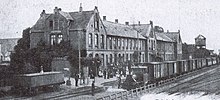Butjadinger Railway
| Nordenham – Eckwarderhörne | |||||||||||||||||||||||||||||||||||||||||||||||||||||||||
|---|---|---|---|---|---|---|---|---|---|---|---|---|---|---|---|---|---|---|---|---|---|---|---|---|---|---|---|---|---|---|---|---|---|---|---|---|---|---|---|---|---|---|---|---|---|---|---|---|---|---|---|---|---|---|---|---|---|
| Course book section (DB) : | 221p (1956), 198m (1935) | ||||||||||||||||||||||||||||||||||||||||||||||||||||||||
| Route length: | 30.1 km | ||||||||||||||||||||||||||||||||||||||||||||||||||||||||
| Gauge : | 1435 mm ( standard gauge ) | ||||||||||||||||||||||||||||||||||||||||||||||||||||||||
|
|||||||||||||||||||||||||||||||||||||||||||||||||||||||||
The Butjadinger Bahn (Plattdt. Butjenter Bahn) was a standard-gauge small railway on the Butjadingen peninsula in the north of the Wesermarsch district in Lower Saxony . It connected the port city of Nordenham on the Weser with Eckwarderhörne on the Jade Bay, from where ships to Wilhelmshaven still leave today .
Prehistory and construction
Traffic conditions in Butjadingen were extremely modest up until the 20th century . There were hardly any weatherproof roads and therefore no reliable connection between the many small towns on the peninsula and with the city of Nordenham, which had been connected to the network of the Grand Ducal Oldenburg Railway (GOE) via the railway line to Hude since the 1870s . In particular, there was also no good way of transporting the predominantly agricultural products from Butjadingen.
For these reasons, initiatives developed in the years after 1900 that fought for a better connection to the north Ham hinterland. After the Oldenburg state government had already decided at the beginning of 1906 to build a railway from Varel to Rodenkirchen (which the Butjadinger felt disadvantaged because of the route through Stadland ), the Butjadinger district council also decided on November 2, 1906, to use a small railway from Nordenham To build Stollhamm and Tossens to Eckwarderhörne. The state of Oldenburg granted a grant of 400,000 marks and 40% of the construction costs for the route west of Stollhamm.
After the building permit had been granted , construction could begin in the early summer of 1907. A lack of building permits, especially for small bridges, severely hampered construction, so that although no major engineering structures or substructure work were required, the route could only be opened on August 15, 1908.
The “Hotel auf dem Deiche” of the city's founder, Wilhelm Müller, located in Nordenham had already been converted into a train station (the middle section in the picture) and sold to the Oldenburg State in November 1875. On October 15, 1875, the first train ran the Hude - Nordenham route.
Operation and flowering period
The final route ran from Nordenham via the towns of Ellwürden, Abbehausen, Moorsee, Stollhamm, Mitteldeich, Burhave, Langwarden, Ruhwarden, Tossens and Eckwarden to Eckwarderhörne with a total length of 30.1 km. The Butjadingen Office was responsible for the management . In Eckwarderhörne there was a ship connection to Wilhelmshaven, in Nordenham to the state railway.
The passenger numbers developed positively from the beginning, also benefited by the large number of holiday guests, so that a more powerful locomotive soon had to be procured. In the 1913/14 financial year, more than 240,000 passengers and almost 28,000 tons of goods were carried, and the railway made a profit.
However, the long journey times of around 90 minutes were noticeable even for a small train. They arose from the fact that freight wagons were delivered to almost all trains en route, which resulted in longer stops at intermediate stations.
Between the wars, the railway kept afloat, until the number of transports rose to new record levels after the Second World War, especially due to hamster trips .
Decline
Slow steam locomotives and railcars as well as poor superstructures led to less and less attractive travel times in view of increasing car traffic. As a result, the number of passengers on the Butjadinger Railway decreased and it could no longer work economically. 1956 came the final end for passenger traffic.
In the same year, the freight traffic was also handed over to the Deutsche Bundesbahn . It carried this out to Eckwarden until the end of October 1959, after which only the remainder remained to Stollhamm. By the end of 1968, the rest of the traffic was also set and the route abandoned. After the piece to Eckwarderhörne had already been dismantled, the remaining facilities followed.
The section between Nordenham and Stollhamm of the former railway embankment has been converted into a cycle path and is therefore part of the extensive cycle path network used by tourists in Butjadingen. Numerous station buildings have been preserved to this day and are used for other purposes.
Traction vehicles
In addition to three two- and one three-axle steam locomotive from the early days, two railcars were also used. The four-axle T 1 railcar initially came to the Steinhuder Meer-Bahn , later it was sold to private customers via a museum railway. The two-axle T 2 , which came to the Delmenhorst-Harpstedter Eisenbahn after operations were closed , has been preserved to this day.
literature
- Hinrich Rudolfsen et al .: The Butjadinger Bahn. Kenning Verlag, 1998. ISBN 3-927587-98-2 .


